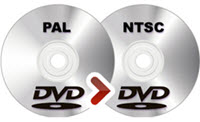

Now throw both the NEW NTSC compliant and the NEW longer AUDIO into SpruceUp (or whatever) and make your chapters based on the original.

once it is done, I would advise re-encoding it back to whatever it came as (AC3 or MPA or whatever, so you can save space and get the highest video bitrate (as per RobShots page) This will make the tempo slower JUST the right amountĤ. Pitch & Time settings can be default use high precision. Do a constant stretch, not gliding (stretch mode is TIME STRETCH, PRESERVE PITCH. To do this, go to TRANSFORM.TIME/PITCH.STRETCH. You actually want the file to be 104.297% the length of the original. SO you want the audio to be SLIGHTLY longer. Remember the original film ran at 25fps and it will now run at 23.97 fps. convert the file into a WAVE (using SoftEncode, or SoundForge or WinAmp or any other method you like)ģ. get the audio off DVD2AVI in the usual mannerĢ. when CCE is finally done, use Pulldown.exe to 'fix' the file so it can be imported into the DVD authoring programġ. Please note that it takes notably longer than doing a native NTSC file cos it is doing all the voodoo to get it over to an NTSC compatible fileĨ. I then simply follow the excellent Robshot guide for 2-pass CCE encoding. drag and drop that into CinemaCraft Encoder 2.50 (HAS to be 2.5 not higher)ħ. save the AVIscript as something sensible (eg PAL2NTSC.avs)Ħ. Return clip._ReverseFields(default(ShiftDown,1))ĥ. LoadVirtualdubPlugin("ReverseFields.vdf", "_ReverseFields") create my AVIsynth converting script based on the details below:įunction ReverseFields(clip clip, int "ShiftDown")


make sure the ReverseFields.vdf filter is in the same folder as the AVIsynth script below so it can find itĤ. No clipping or resizing either (we will use AVIsynth to change from PAL to NTSC resolutions)ģ. use DVD2AVI with the video setting at NONE. I am not claiming to be an expert, and freely admit that I gleaned this info from other sites.Ģ.


 0 kommentar(er)
0 kommentar(er)
